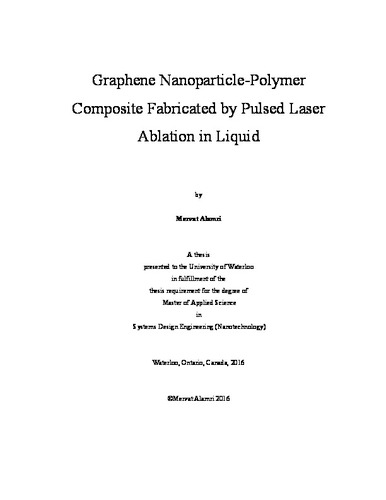| dc.description.abstract | Graphene is an attractive alternative material for diverse applications in electronic devices, fuel cells, biomedical sensors, energy storage, and super-capacitors due to its exceptional thermal, electrical, optical and mechanical properties. This material can be synthesized by many effective methods such as chemical vapor deposition (CVD), micromechanical exfoliation of graphite, and reduction of graphene oxide. Each of these methods has its advantages and disadvantages.
This thesis investigates a novel and clean approach to grow graphene directly from bulk graphite by Pulsed Laser Ablation in Liquid, whereas the graphite sheets are immersed in different polymeric solutions (deionized Water, Ethanol, and Toluene) and exposed to two types of lasers (nanosecond and femtosecond lasers). This technique is simple, and fast; a one-step procedure to fabricate pure and stable graphene nanoparticles (GNPs) by short ablation time. It results in controllable-size products, high mass production, high stability, less aggregation, and absence of chemical agents, a known disadvantage observed in other approaches for graphene production.
The ablation parameters had been optimized for the best formation efficiency of Pulsed Laser Ablation in Liquid (PLAL) process, after controllably varied trials, which are: 532 nm and 800 nm λ -wavelength for the nanosecond laser and femtosecond laser respectively, with pulse width of 150 ns for ns-laser and 35 fs for fs-laser. The pulse energy are 800 µJ and 250 μJ for the ns-laser and fs-laser respectively, 1kHz is the repetition rate for both lasers. Ablation times are 20 minutes for ns-laser and 1-2 hours for fs-laser, and 5 cm focal length for the focusing lens.
Confirming the presence of graphene in solutions or in fabricated thin films is carried out by several characterization techniques including Raman; UV-VISIBLE; atomic force microscopy (AFM); scanning electron microscope (SEM); and transmission electron microscopy (TEM).
These techniques allow an insight into the morphological and structural properties of the produced graphene, confirming the purity; particle size uniformity; as well as the number of graphene layers.
This thesis attempts to interpret three main aspects of graphene growth: the advantages of the use of the PLAL approach and how it overcomes some of the reported challenges in graphene growth processes; the function of the contribution of different polymers which enhances the formation efficiency, and prevents agglomeration of carbon-based materials of the prepared GNP. Finally, the potential recipe that had been used for growing high quality graphene, with controllable thickness and particle size, was employed in the results section of this thesis. | en |

